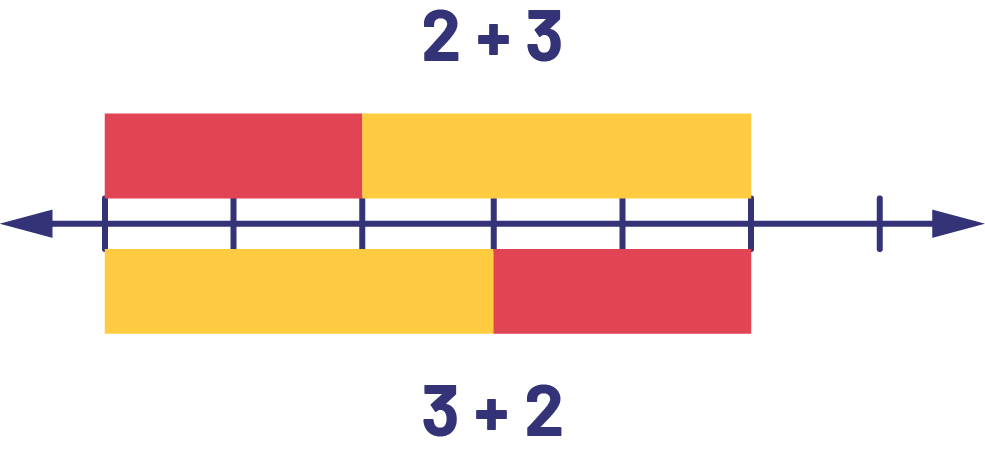B2.1 Use the properties of addition and subtraction, and the relationship between addition and subtraction, to solve problems and check calculations.
Skill: Using the Properties of Addition and Subtraction to Solve Problems and Check the Reasonableness of Calculations
It is not necessary for elementary students to know the names of the properties. The goal is to get them to use them naturally to combine numbers.
Students demonstrate their understanding of the properties of mathematical operations when they use concrete materials, drawings, words, or symbols to represent mathematical ideas and relationships.
Source: translated from Guide d’enseignement efficace des mathématiques de la 1re à la 3e année, Modélisation et algèbre, Fascicule 2, Situations d'égalité, p. 17.
The properties of addition are:
- commutative property (for example, 1 + 2 = 2 + 1);
- zero property (adding zero leaves the original quantity unchanged) (for example, 1 + 0 = 1 and 0 + 1 = 1).
The property of subtraction is:
- the zero property for subtraction (subtracting zero leaves the original quantity unchanged) (for example, 1 - 0 = 1).
Source: trranslated from Guide d’enseignement efficace des mathématiques de la 1re à la 3e année, Numération et sens du nombre, p. 33.
Commutative Property
Students who recognize the commutative property of addition can reduce the number facts they need to learn in half. Visual representation of facts such as 3 + 2 and 2 + 3 helps students grasp this relationship.
Source: translated from Guide d’enseignement efficace des mathématiques de la maternelle à la 6e année, Fascicule 5, p. 19.

Zero Property (Property of the Number 0 in Addition and Subtraction)
When using the zero property in addition, teachers encourage students to propose conjectures such as, "If I add 0 to a quantity (for example, 5 + 0), that quantity stays the same, and if I add any quantity to 0 (for example, 0 + 5), I get the quantity that I added.
By applying these conjectures to different numbers, students will be able to formulate a generalization that this property of the number 0 is true for all numbers.
For the zero property in subtraction, teachers encourage students to propose a conjecture such as, "When I subtract 0 from a number (for example, \(5 - 0\)), I get the starting number." By applying this conjecture to different numbers, students will be able to formulate a generalization that this property of the number 0 is true for all numbers.
Source: translated from Guide d’enseignement efficace des mathématiques de la 1re à la 3e année, Modélisation et algèbre, Fascicule 2, Situations d'égalité, p. 93 et 95.
Skill: Using the Relationship Between Addition and Subtraction to Solve Problems and Check the Reasonableness of Calculations
Relationship Between Addition and Subtraction
Understanding the connections between operations (for example, addition and subtraction are inverse operations) supports students in learning learn basic number facts and solving problems.
Source: translated from Guide d’enseignement efficace des mathématiques de la 1re à la 3e année, Modélisation et algèbre, Fascicule 2, Situations d'égalité, p. 32.
Addition and subtraction are inverse operations. When students are learning these operations, they often have difficulty solving equations such as 17 + ___ = 31. Teachers often encourage their students toward using the inverse operation, subtraction, as a strategy to find missing terms. However, this technique can easily slip from memory unless students truly grasp why it works.
Students need to grasp the relationship of the whole to its parts, and the meaning of the difference between two numbers. For example, a number can be represented in a bar model (part/whole) diagram as follows:

This way of representing the relationship between a number and its parts allows us to see that subtraction is the inverse operation of addition. Thus, since 10 + 8 = 18 and 8 + 10 = 18, then 18 - 10 = 8 and 18 - 8 = 10. In addition, students can see that addition is commutative (10 + 8 = 8 + 10) and that subtraction is not (18 - 10 ≠ 18 - 8). Students who have developed good number sense and are able to decompose and group numbers can use their knowledge to more effectively solve equations such as \(10 + \mathord{?} = 18\) by understanding that they can use subtraction to find the answer or think about the difference between 10 and 18.
Source: translated from Guide d’enseignement efficace des mathématiques de la 4e à la 6e année, Numération et sens du nombre, Fascicule 1, Nombres naturels, p. 97-98.
Knowledge: Properties of Operations
Properties of operations relate to the ways that numbers behave when operations are applied to them.
Source: translated from Guide d’enseignement efficace des mathématiques de la 4e à la 6e année, Numération et sens du nombre, Fascicule 1, Nombres naturels, 102.
Knowledge: Commutative Property
The Commutative Property states that the order of adding (or multiplying) two numbers does not matter because the solution will be the same. In Grade 1, students should understand that addition is commutative, while subtraction is not.
Example
\(\ 2 + 3 = 3 + 2\)
\(\ 6 - 3 ≠ 3 - 6 \)
Source: adapted from Guide d’enseignement efficace des mathématiques de la 4e à la 6e année, Numération et sens du nombre, Fascicule 1, Nombres naturels, p.102.
Knowledge: The Identity Property
The identity property occurs when a number is combined with a special number (identity element) by using one of the operations, and the result leaves the original number unchanged. In addition, and subtraction, the identity element is 0; for example, for example, \(7 + 0 = 7\) and \(0 + 7 = 7\).
In a subtraction, the number 0 has no effect only when it is the second term (for example, (3 - 0 = 3)).
Source: Ontario Curriculum, Mathematics Curriculum, Grades 1-8, Ontario Ministry of Education, 2020.
